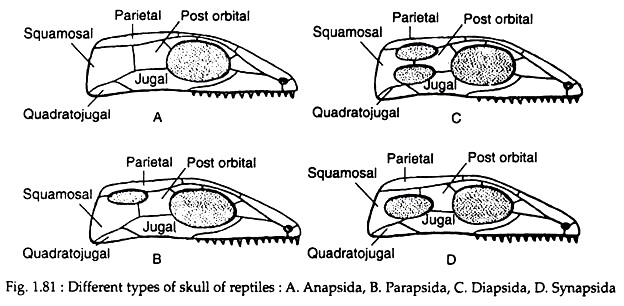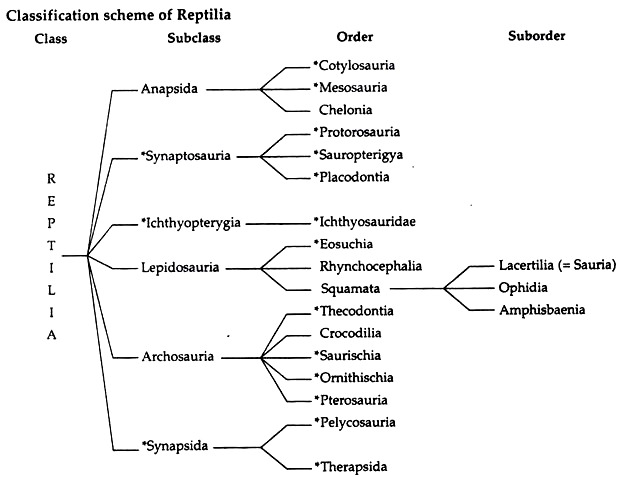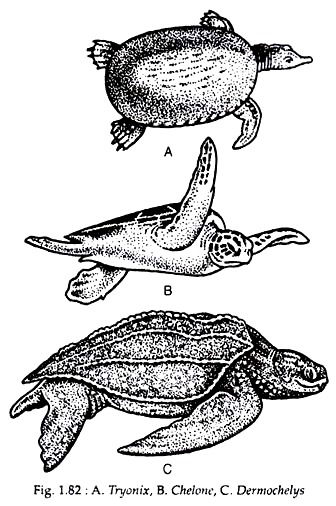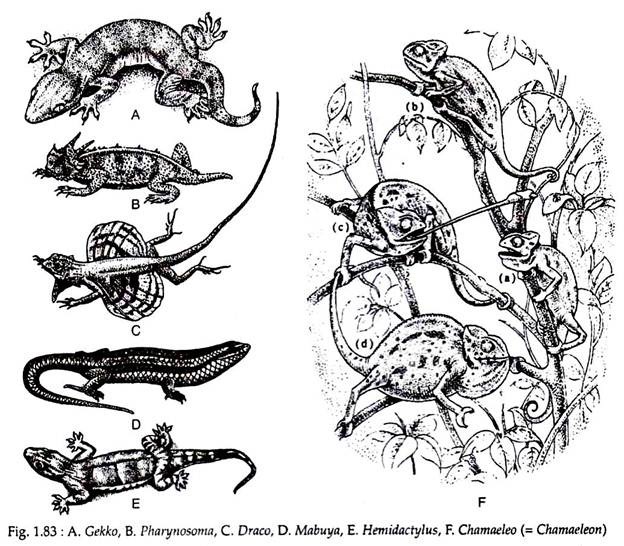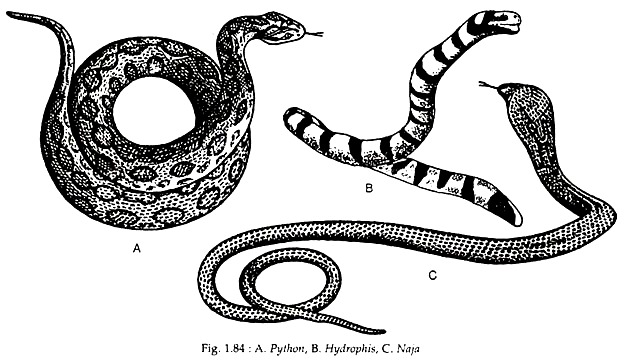In this article we will discuss about the characters and classification of reptilia.
Reptiles are cold-blooded vertebrates, breath by lungs and having the body covered by scales or scutes. A basioccipital bone is present in the skull which articulates with the vertebral column by a single condyle. In 1895, herpetologists separated reptiles from Amphibia as a different class.
They classified reptiles especially on the basis of skeletal characters. The major characteristic feature is the fossa of the temporal region, i.e., behind the orbit, of the skull.
On the basis of fossa or fossae of the reptilian skull they are classified into four groups (Fig. 1.81):
1. Anapsida — without any opening in the temporal region.
2. Parapsida — The skull possesses an upper opening in which the post-orbital and squamosal meet below.
3. Diapsida — In this case there are two openings on each side, separated by pos- torbital and squamosal bones.
4. Synapsida — In this group a single opening is present with postorbital and squamosal meeting above.
Since the separations of reptiles from amphibians at the last part of nineteenth century, different herpetologists came forward to classify them. Therefore, several schemes of classification exist. Here the classificatory scheme proposed in ‘The life of vertebrates’ by J. Z. Young (1981) is followed. The detail discussion on general characteristics is made only for extant orders.
Class — Reptilia:
General characters:
1. They are inhabitants of terrestrial and aquatic (both marine and freshwaters) environments.
ADVERTISEMENTS:
2. Their skin is dry, cornified and usually covered by epidermal scales or scutes. There are a few integumentary scent glands secreting pheromones during breeding seasons.
3. Single external nasal opening is present on the snout. Ear drums are slightly depressed.
4. Two pairs of pentadactyle limbs are present. The limbs end in clawed digits.
5. The cloacal opening is either transverse or longitudinal.
6. A post-anal tail is present.
7. The heart is composed of two auricles and a partially divided ventricle. There are right and left systemic arches.
8. The kidney is metanephric type.
9. Mullerian duct persists as oviduct in female and Wolffian duct is retained as vas deference in male. Males possess copulatory organs.
10. Twelve pairs of cranial nerves are present.
ADVERTISEMENTS:
11. Vomero-nasal organ (Organ of Jacobson) is well-developed.
12. Single occipital condyle in the skull is present for the attachment with atlas.
13. Mandible consists usually six pieces of bones.
14. Vertebrae are procoelous. Sternum is greatly developed with ribs.
15. Cleidoic eggs are large. The calcareous shell serves for protection against desiccation and external injury. The shell is porous for gaseous exchange.
16. Fertilisation is internal.
17. Embryos are provided with extra-embryonic membranes, like amnion, chorion and allantois.
18. These are ectothermic or heliothermic (Gk. helios = sun) animals.
Subclass — Anapsida:
General characters:
1. The roof of the skull is solid.
2. The skull is devoid of fossae behind the eyes.
Order — Chelonia (Gk. Chelone = a tortoise):
General characters:
1. Body is dorsoventrally flattened and more or less elliptical.
2. Body is dorsally covered by a shield like carapace and ventrally by a plate, plastron. The shell is externally protected either with polygonal scutes or leathery scales.
3. Neck, limbs and tails are retractile. Tail is very short.
4. Weak limbs are pentadactyle and in some marine forms modified into paddles.
5. In adults, teeth are absent and the jaws are covered by sharp horny plates.
6. The cloacal opening is longitudinal. The male possesses a copulatory organ that remains attached to the ventral wall of cloaca.
7. These are oviparous animals.
8. In temperate regions, all chelonians hibernate regularly.
9. In the skull, quadrate bone is immovably articulated, i.e., monimostylic.
10. Thoracic vertebrae and ribs are usually fused with carapace.
11. Pectoral girdle consists of a scapula, a long pro-coracoid, and a coracoid.
12. The pelvic girdle is composed of ilia, ischia, and pubis.
Examples:
Testudo, Emys, Trionyx (Indian soft shell turtle, Fig. 1.82A), Chelone (Green turtle, Fig. 1.82B), Dermochelys (Leather back turtle, Fig. 1.82C), Chelys, Lepidochelys olivacea (Olive Ridley turtle) etc.
Subclass — Lepidosauria (Gk., Lepis = scale; Squaros = Lizard):
General Characters:
1. The skull of the members of this group has two temporal vacuities; i.e., diapsid skull.
2. Lizard-like reptiles with scaled skin.
This subclass includes three orders — Eusuchia, Rhynchocephalia and Squamata. Among these three orders, Eusuchia is extinct.
Order — Rhynchocephalia (Gk., Rhynchos = a beak/snout; Kephale = a head):
General characters:
1. The skin is dorsally dull olive green and ventrally whitish in colour. Dorsal side is covered by small granular scales and on the ventral side the scales are transformed into transverse square plates of larger size.
2. Tail is bilaterally compressed and crested with power of regeneration.
3. At the dorsal side a median row of erective spines (frill) extends from the top of the head to the tip of the tail.
4. The eyes are large with vertical pupil.
5. The cloacal aperture is a transverse slit.
6. Males lack copulatory organ.
7. Skull is composed of paired premaxillae, nasals, frontals, and parietals. The quadrate is immovable.
8. Vertebrae have amphicoelous centra with persistent notochord. A so-called pro-atlas is present.
9. Almost all the vertebrae possess chevron bone.
10. Abdominal ribs are present. The ribs are single headed and bony.
11. The teeth are of acrodont type. Small triangular teeth are present on the maxilla, palatine and mandible.
12. Vomerine teeth are present in youngs but in adults these are replaced by pads.
13. Brain is simple with a very well-developed parietal organ (third eye).
14. The fertilised eggs take over a year to hatch.
Examples:
Sphenodon punctatus and S. guntheri.
Order — Squamata (Latin, sqamatus = scaly):
General Characters:
1. The skull of these animals bears superior temporal fossa.
2. The maxilla, palatine and pterygoid are immovably articulated with the skull, but the quadrate is movable.
3. Lower jaw is composed of several pieces of bones.
4. Teeth are either acrodont or pleurodont type and are borne usually on the maxillae, premaxillae and palatines.
5. Vertebrae are of procoelous type and possess chevron bone.
6. The ribs are single-headed.
7. Cloacal aperture is a transverse slit.
8. One pair of reversible copulatory sacs are present in males.
9. Organ of Jacobson is well-developed.
10. They are distributed all over the world, i.e., cosmopolitan.
Examples:
All lizards and snakes are included in this order.
The lizards and snakes possess distinct characteristic features. So it will be better to study this order up to suborders. This order squamata is divided into three suborders — Lacertilia, Ophidia, and Amphisbaenia.
The details of these suborders are:
Suborder — Lacertilia (Latin: lacerta = a lizard):
General Characters:
1. The elongated body is provided with two pairs of limbs and long tail.
2. Upper and lower eyelids are usually movable.
3. Quadrate is slightly movable.
4. Sternum with a ‘T’-shaped episternum.
5. Tympanum is distinct.
6. Tongue is broad and usually entire.
7. Urinary bladder is present.
Examples:
Phrynosoma (the horned toad lives in the deserts of Mexico and Southwestern USA) (Fig. 1.83B), Chamaeleo (= Chamaeleon) zeylanicus (Only Indian species) (Fig. 1.83F), Leiolepis, Uromastyx hardwickii (found in the arid zones of Rajasthan, Punjab and U.P.). Calotes versicolor (Garden lizard of India), Draco (Flying lizard) (Fig. 1.83C), Moloch horridus (Thorny devil or spiny lizard of Australia), Gekko (Giant house lizard of India) (Fig. 1.83A), Hemidactylus (Common house lizard) (Fig. 1.83E), Mabuya (Common shink) (Fig. 1.83D), Ophisaurus gracilis (known as Burmese glass snake, is the only Indian limbless lizard), Varanus bengalensis, Heloderma (USA, the only poisonous lizard of the world).
Suborder — Ophidia (= Serpentes) (Latin — Serpentes = Serpent):
General Characters:
1. These are commonly known as snakes. Typically scally, wormlike animals, devoid of limbs, limb-girdles and tympanic membrane.
2. Eyes are protected by a scale modified as transparent spectacles. There are no movable eyelids.
3. Temporal fossae are totally absent due to secondary mode of adaptation.
4. Vomero-nasal or Organ of Jacobson is highly developed.
5. Maxillae, palatines and pterygoids are freely movable. The rami of the mandible are connected by elastic ligaments.
6. Quadrate is highly flexible.
7. Sternum and episternum are absent.
8. Tympanic membrane, tympanic cavities and eustachian tubes are reduced or absent.
9. Vertebrae possess additional intervertebral articulations known as zygantra and zygosphenes.
10. They possess a deeply forked highly sensitive tongue, which acts as thermo-, chemo- and tactile-receptor.
11. Most of the snakes are oviparous, some are viviparous.
Examples:
Python molurus (Indian rock python) (Fig. 1.84A), Boa constrictor (Boa), Eryx johni (Red sand boa), Typhlops acutus (beaked Indian blind snake), Ptyas mucosus (rat snake), Chrysopelea oruata (flying snake), Elachistodon westermanni (Indian egg eater snake), Naja (Cobra) (Fig. 1.84C), Bungarus (Krait), Vipera russelli (India, russells viper), Hydrophis (Fig. 1.84B) (Sea snake) etc.
Suborder — Amphisbaenia (Greek: Amphi = both, baino = to go):
General Characters:
1. These are worm-like lizards having no limbs.
2. The worm-like body is covered with soft skin possessing numerous rings, which are divided into little squares.
3. The eyes and ears are completely concealed under the skin.
4. The tail is very short.
5. Fossorial creatures having compact and highly ossified skull.
6. Teeth either acrodont or pleurodont type.
7. They can crawl easily in both backward and forward direction.
Examples:
Amphisbaena fuliginosa (South America and West Indies), Blanus (Mediterranean region).
Subclass — Archosauria:
General Characters:
1. The skull is of diapsid type and lacked inter-parietal and parietal foramina.
2. Some forms are toothless and in others only palatal teeth are lost.
3. The lower jaw is with vacuities between dentary and angular.
4. In some advanced forms bipedality was present and the girdles were modified accordingly.
Order — Crocodilia/Loricata (Latin: Crocodilus = a crocodile; Loricatus = clad in nail):
General Characters:
1. These are fresh water reptiles and carnivorous in habit. They swim by the undulation of powerful laterally compressed tail.
2. They creep on land with the help of their less powerful limbs.
3. Pentadactyle limbs, forelimb possesses webbed digits.
4. The skin bears epidermal scales. The scales are supported by dermal bones or scutes.
5. The cloacal aperture is longitudinal.
6. Males are provided with single and median erectile copulatory organ. A clitoris is present in female.
7. Thecodont teeth are present on premaxillae, maxillae and dentaries. The teeth have persistent palp.
8. The nostrils are situated at the tip of the snout and the single internal nare is situated at the back of the buccal cavity.
9. An incipient diaphragm is situated between thoracic and abdominal wall.
10. The heart is four chambered.
11. The eyes are provided with pecten.
12. The skull has persistent sutures. Inter-orbital septum is well-developed with a large alisphenoid.
13. The quadrate is large and immovable.
14. Vertebrae are either amphicoelous or procoelous type. The caudal vertebrae are provided with chevron bones.
15. The vertebral column is divisible into cervical, thoracic, lumbar, sacral and caudal regions.
16. Sternal and abdominal ribs are present. Sternal ribs have uncinate process. Most of the ribs are double-headed.
17. The pectoral girdle consists of dorsal scapula and ventral perforated coracoid. There is an epicoracoid, which is a thin strip between sternum and coracoid.
18. The pelvic girdle consists of a large ilia, a small pubis and ischium. An epipubis is present and the symphysis is ischiopubic in nature.
Examples:
Alligator mississippiensis (American), A. sinensis (China), Crocodylus palustris (Indian), C. porosus (salt water crocodile of Indo-pacific region), C. niloticus (Nile River), Gavialis gangeticus (Gharials of India, Ganga River).
Reptiles are the first true terrestrial vertebrates that dominated the earth during Mesozoic period. Towards the end of the Devonian period the vertebrates produced a population of amphibian creatures. From this has been derived not only various modern amphibian classes but also the more fully terrestrial populations that do not need to breed in water — they are known as amnoita. Since that time many divergent lines have evolved from this stock, including the birds and the mammals.
It is evident from the above discussions that the existing reptiles belong to four out of the dozen or more main lines that have existed. The most successful modern forms are placed in the order Squamata, the lizards and snakes, the latter being of relatively recent appearance in their present state. Secondly, the tuatara, Sphenodon of New Zealand is a relic surviving with little change from the Triassic beginnings of this group.
Thirdly, the crocodiles are an older offshoot from the stock from which the modern birds were derived. Finally, the tortoises and turtles (Chelonia) have retained, in some respects, the organisation of still earlier times. These four modern types are all that remain of the reptiles that flourished throughout the Mesozoic, culminating in the giant dinosaurs of the Jurassic and Creataceous.
